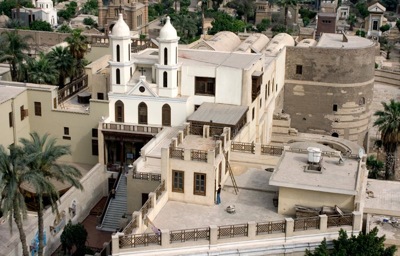 |
| The Hanging Church, courtesy, Coptic-Cairo.com |
History books give the foundation year of Cairo as 972 and built by the
Fatimid Arabs. This, however, is not true. Present-day Cairo was actually an
outgrowth of several ancient sites in the area namely, Memphis, at one time, the capital of ancient Egypt, today hovering around
Cairo’s southern border. Heliopolis also
served as capital when Memphis was not. It hovers on Cairo’s northern border.
In between, the ancient Egyptians erected several monuments that have stood the
test of time including: the Pyramid of
the Pharaoh Djoser, the Pyramids of
Giza, and the Sphinx. In the 6th century BCE, the Persians built a
fort settlement on the Nile and called it “Babylon”
after the ancient city on the Euphrates. The Persians also built a canal from the Nile (from today’s Fustat) to the Red Sea. From that time and for many centuries afterwards, Babylon
gained importance while nearby Memphis, as well as Heliopolis declined.
In the period when Egypt was under Roman
occupation, it is believed, in Christian tradition, that the Cairo area was one
of the places the Holy Family visited during
their flight from Judea to Egypt, and they stayed at the site that became the Church of Saints Sergius and Bacchus (today, in the neighborhood of Abu Serga). By the 4th century, as Christianity spread in
Egypt, the Copts staged a revolt against Roman rule, but it was summarily
crushed resulting in the Romans establishing a
fortress and settlement on the site of the old Persian structures built centuries
earlier. It was that fortress settlement that became the nucleus of the Cairo proper,
and Coptic Cairo in particular. In the late 4th and early 5th
centuries, many churches were established in the area. The Hanging Church, located on the fortress grounds and so named
because it was built over the southern
gate, was said to have been built during the time of the Patriarch Isaac
(690-692), fifty years after the conquest of Egypt by the Arabs. Eventually, it
became the official seat and residence of the Coptic Pope and remained
so for the next 1200 years. Alexandria remained the historic and traditional
seat until today.
Since the Arab conquest
and probably until the 8th century, the neighborhood of Fustat, the
first Arab settlement in Egypt which intermittently served as capital of the
local Arab occupation, was also a Coptic center. It is said that the Amr ibn al As Mosque, named after the
leader of the Arab conquerors, was built in part from columns stolen from local
Coptic churches.
The Moqattam area of Cairo was, according
to Coptic tradition, the scene of the moving of the Moqattam Mountain. Al-Mu’izz, a Fatimid Arab caliph, asked
Patriarch Abraham (reigned 975-978), the 62nd patriarch, to prove
the truth of a verse in the Bible (Matthew 17:20) that he believed related to
the Mountain: “Because you have so little faith. Truly I tell
you, if you have faith as small as a mustard seed, you can say to
this mountain, ‘Move from here to there,’ and it will move. Nothing will
be impossible for you.” After three days of praying and fasting for
guidance in front of a painting of the Virgin Mary, the Virgin Mary appeared to
the Patriarch in a vision and instructed him on his response. When he returned
to the caliph, he made the Mountain move. Al-Mu’izz was therefore convinced of
the truth of the Christian faith and thereafter, allowed the Coptic Church
certain privileges. However, from the 12th century onward, the Copts
suffered persecution and high taxation imposed on them by the Arab authorities.
This problem became so acute, that they felt forced to sell one of their
churches, built in the 8th century, to the local Jewish community
who thereupon built the Ben Ezra Synagogue which still stands (empty) today.
Since 1300, the Papal seat was
transferred several times to different locations around Cairo: in 1300, to the Church of Saint Mercurius; in 1400, the Church
of Saint Mary in Harat Zawila neighborhood;
in 1660, under Pope Matthew IV, to the Church of the Virgin
Mary in Harat Elroum neighborhood;
in 1800, under Pope Mark VIII, to Saint Mark's Coptic Orthodox Cathedral, in Azbakeya neighborhood;
and in 1971, to Saint Mark’s Cathedral
in Abbassiya neighborhood where it
remains today.
In 1908, after receiving approval and a number of silver
antiquities from Patriarch Cyril V and raising funds by public subscription, a
certain Marcus Simaika Pasha built the Coptic
Museum and inaugurated it on March 14, 1910. It was a modern
architectural wonder, competing with some of the local churches. Some of the most
prominent churches found in and around Cairo today, aside from those mentioned
above, include: Saint George and Saint
Abraam, Saint Gawargious and Saint Anthony, and Saint Mark Churches, located in Heliopolis; Saint Marc, and Saint Mona
Churches in Giza; Saint Mary in Masarra; Saint Mary and Saint Bishoy,
and Saint Mary and Saint Rewies, in Abbassiya; Saint Mary in Zeitoon; Saint Saman el Dabagh in Moqattam;
Saint Mary, Archangel Saint Mikhail, Saint
Anthony, and the Martyrs Saint Philopateur
and Saint Demyana Churches in Shoubra;
Saint George in el Zaher; Saint Mary
in Ard el Golf; Saint Marc in el Maady; The Virgin Mary in el Faggala; Saint Mary in el Matareyta; Saint George in Almaza; Saint Mary, and Saint Mina Churches in Old Cairo; Saint Barbara in el Sharabiya; Saint George and Saint Abo Sefein, and Saint Mary Churches in Central Cairo; Saint Mona in al Farag; the Holy Virgin in Babylon el
Darag; Saint Menas in Fum al Khalig;
and Saint Mona in Garden City.
No comments:
Post a Comment